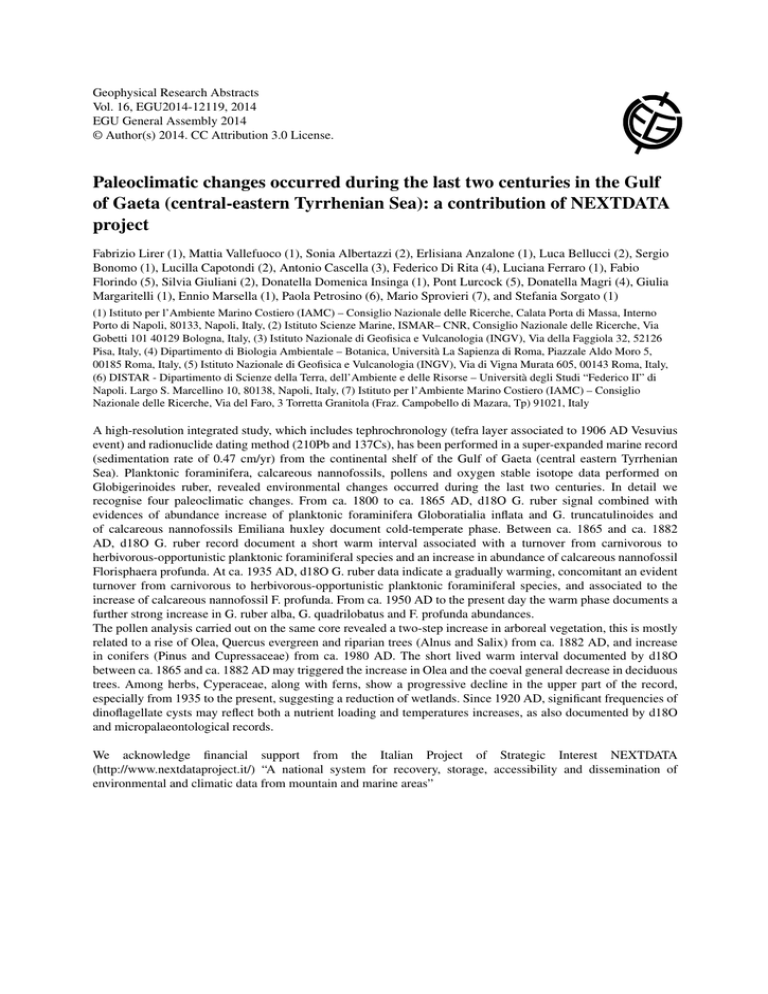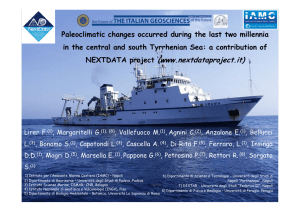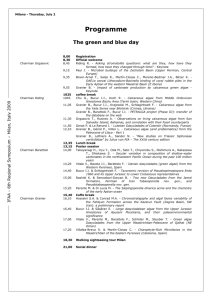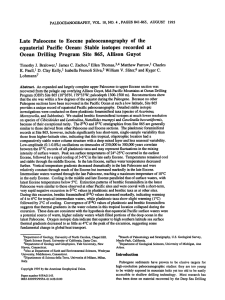Paleoclimatic changes occurred during the last two centuries in the
advertisement

Geophysical Research Abstracts Vol. 16, EGU2014-12119, 2014 EGU General Assembly 2014 © Author(s) 2014. CC Attribution 3.0 License. Paleoclimatic changes occurred during the last two centuries in the Gulf of Gaeta (central-eastern Tyrrhenian Sea): a contribution of NEXTDATA project Fabrizio Lirer (1), Mattia Vallefuoco (1), Sonia Albertazzi (2), Erlisiana Anzalone (1), Luca Bellucci (2), Sergio Bonomo (1), Lucilla Capotondi (2), Antonio Cascella (3), Federico Di Rita (4), Luciana Ferraro (1), Fabio Florindo (5), Silvia Giuliani (2), Donatella Domenica Insinga (1), Pont Lurcock (5), Donatella Magri (4), Giulia Margaritelli (1), Ennio Marsella (1), Paola Petrosino (6), Mario Sprovieri (7), and Stefania Sorgato (1) (1) Istituto per l’Ambiente Marino Costiero (IAMC) – Consiglio Nazionale delle Ricerche, Calata Porta di Massa, Interno Porto di Napoli, 80133, Napoli, Italy, (2) Istituto Scienze Marine, ISMAR– CNR, Consiglio Nazionale delle Ricerche, Via Gobetti 101 40129 Bologna, Italy, (3) Istituto Nazionale di Geofisica e Vulcanologia (INGV), Via della Faggiola 32, 52126 Pisa, Italy, (4) Dipartimento di Biologia Ambientale – Botanica, Università La Sapienza di Roma, Piazzale Aldo Moro 5, 00185 Roma, Italy, (5) Istituto Nazionale di Geofisica e Vulcanologia (INGV), Via di Vigna Murata 605, 00143 Roma, Italy, (6) DISTAR - Dipartimento di Scienze della Terra, dell’Ambiente e delle Risorse – Università degli Studi “Federico II” di Napoli. Largo S. Marcellino 10, 80138, Napoli, Italy, (7) Istituto per l’Ambiente Marino Costiero (IAMC) – Consiglio Nazionale delle Ricerche, Via del Faro, 3 Torretta Granitola (Fraz. Campobello di Mazara, Tp) 91021, Italy A high-resolution integrated study, which includes tephrochronology (tefra layer associated to 1906 AD Vesuvius event) and radionuclide dating method (210Pb and 137Cs), has been performed in a super-expanded marine record (sedimentation rate of 0.47 cm/yr) from the continental shelf of the Gulf of Gaeta (central eastern Tyrrhenian Sea). Planktonic foraminifera, calcareous nannofossils, pollens and oxygen stable isotope data performed on Globigerinoides ruber, revealed environmental changes occurred during the last two centuries. In detail we recognise four paleoclimatic changes. From ca. 1800 to ca. 1865 AD, d18O G. ruber signal combined with evidences of abundance increase of planktonic foraminifera Globoratialia inflata and G. truncatulinoides and of calcareous nannofossils Emiliana huxley document cold-temperate phase. Between ca. 1865 and ca. 1882 AD, d18O G. ruber record document a short warm interval associated with a turnover from carnivorous to herbivorous-opportunistic planktonic foraminiferal species and an increase in abundance of calcareous nannofossil Florisphaera profunda. At ca. 1935 AD, d18O G. ruber data indicate a gradually warming, concomitant an evident turnover from carnivorous to herbivorous-opportunistic planktonic foraminiferal species, and associated to the increase of calcareous nannofossil F. profunda. From ca. 1950 AD to the present day the warm phase documents a further strong increase in G. ruber alba, G. quadrilobatus and F. profunda abundances. The pollen analysis carried out on the same core revealed a two-step increase in arboreal vegetation, this is mostly related to a rise of Olea, Quercus evergreen and riparian trees (Alnus and Salix) from ca. 1882 AD, and increase in conifers (Pinus and Cupressaceae) from ca. 1980 AD. The short lived warm interval documented by d18O between ca. 1865 and ca. 1882 AD may triggered the increase in Olea and the coeval general decrease in deciduous trees. Among herbs, Cyperaceae, along with ferns, show a progressive decline in the upper part of the record, especially from 1935 to the present, suggesting a reduction of wetlands. Since 1920 AD, significant frequencies of dinoflagellate cysts may reflect both a nutrient loading and temperatures increases, as also documented by d18O and micropalaeontological records. We acknowledge financial support from the Italian Project of Strategic Interest NEXTDATA (http://www.nextdataproject.it/) “A national system for recovery, storage, accessibility and dissemination of environmental and climatic data from mountain and marine areas”


